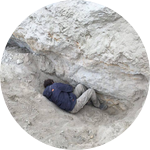Project Results
About This Project
In a metropark in suburban Ohio, there are potentially hundreds of fossils right below our feet. We have mapped nearly 20 sites with fossils in these park, and suspect that they preserve a record of small and large animals from the late Pleistocene to today. At present, we have no idea how old these fossils are, but with your help, we will be able to use radiocarbon dating and pollen analysis to establish the age of these fossils and determine when they were deposited in the caves here.
Ask the Scientists
Join The DiscussionWhat is the context of this research?
This project began as a simple field survey of a region of Southwest Ohio that hadn't been surveyed for any kind of paleontological resources before. Now, with the completion of our initial survey we have uncovered enough sites and samples to suggest a long history of use and habitation of our survey areas. The next step, then, must be to arrange our finds in order of age. To this end we need radiocarbon work done, to add real numerical values to our relative ages. All living organisms are made of carbon of which a small percentage is a radioactive form called Carbon-14. It takes around 100,000 years for this radioactive carbon to leave a bone, and we can use the ratio of C-14 to normal carbon (C-12) to figure out how old bones and other organic samples are.
What is the significance of this project?
This project has uncovered, in one park alone, 12 sites containing the bones of 46 individual animals and 16 species. Mammals (including humans), reptiles, and birds, and fishes are all represented. 2 sites reveal animals no longer living in the region (Gray Wolf, Bobcat, Snowshoe Hare), and another 3 sites we have evidence of human use of the park as well (Stone tools, Butchered bones, Human remains).
What are the goals of the project?
We need to address the timing of sites containing extradited group to help understand how these animals used this portion of the Ohio landscape, and the sites with evidence of humans to figure out the timing human use, and identity of the humans in the park - though we will not need to test human remains directly to accomplish this.
Budget
We currently have 5 sites that are of paleontological and/or archeological significance. Assigning numerical ages to the bones in one of these caves will help us to develop a timeline for animal use of this landscape following the retreat of glacial ice ~20,000 years ago. Additionally, it is our hope that radiocarbon work for one site can help to illustrate the significance of the fossils here, which in turn can be used as a spring board for grant applications further down the road.
Endorsed by
 Project Timeline
Project Timeline
We have been working and preliminary report on this research, which we would like to have submitted for publication by the end of the summer. The next phase of this work, will then be a more in-depth analysis of the material collected thus far.
Jul 16, 2018
Project Launched
Aug 11, 2018
Send samples for testing
Aug 30, 2018
End of fundraising campaign
Sep 02, 2018
Create testing plan: which samples and which testing method
Sep 30, 2018
Interpret results, decide on any follow up testing as needed
Meet the Team
Ryan Shell
I originally graduated from the University of Arkansas in 2013, with a small paper in Dinosaur tracks. I've since moved my focus to marine vertebrates, and am working on manuscripts to that effect at Wright State University, where I am in the 3rd year of my Ph.D. program.
Project Backers
- 10Backers
- 100%Funded
- $647Total Donations
- $64.70Average Donation

